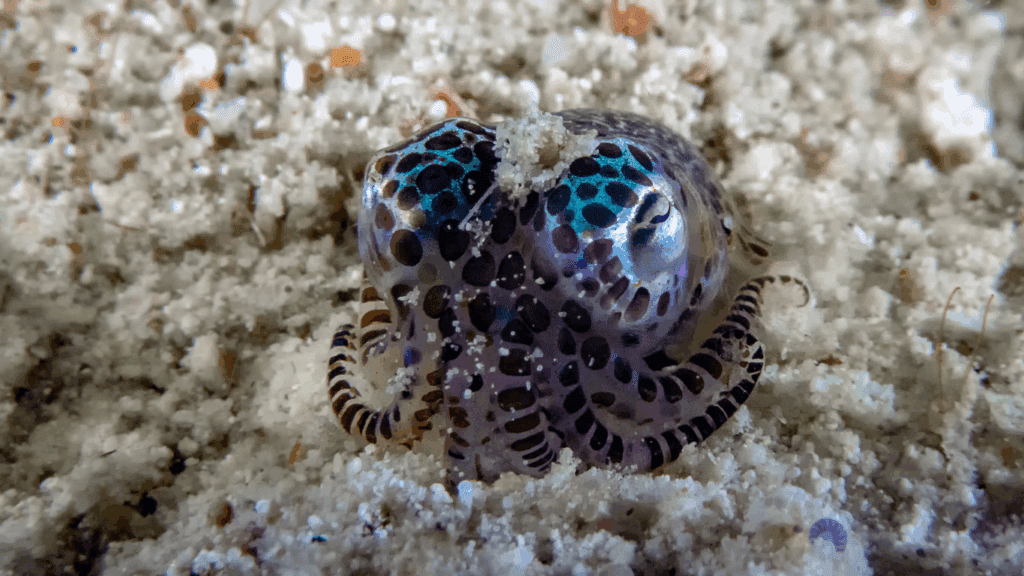7 Surprising Facts About Komodo’s Macro Scene You Need to Know


Table of Contents
Komodo macro diving is one of the most underrated experiences in Indonesia. While most divers come chasing thrilling currents and iconic pelagics, a slower, more intricate world waits to be discovered—one filled with drama, color, and creatures stranger than fiction.
This guide is for divers, underwater photographers, and anyone curious enough to discover this new world.
1. Komodo is a Micro Biodiversity Hotspot
Komodo sits within the Coral Triangle, one of the most biologically rich marine regions on Earth. It’s not just home to sharks and rays—Komodo’s seagrass beds, rubble slopes, and coral outcrops nurture thousands of tiny species. Scientists continue to discover new nudibranch species here, making the area a playground for macro lovers and critter spotters.
2. It’s Not Just Sand—It’s a Whole Ecosystem
When divers hear “macro,” they imagine muck. But Komodo macro diving offers more than black sand and rubble. Look closer: in coral bommies, under mangrove roots, and among feather stars you’ll find entire food webs in motion. Tiny crustaceans, symbiotic relationships between shrimp and gobies, and creatures that mimic their surroundings with astonishing accuracy.
3. Komodo’s Currents Fuel Its Macro Scene
Ironically, the very currents that make Komodo famous for drift dives also fuel its macro diversity. Strong water movement brings nutrients that sustain the tiniest life forms—like filter-feeding tunicates, hydroids, and sponges. These, in turn, become micro-habitats for ornate pipefish, decorator crabs, and other masters of disguise. This is why Komodo macro diving is so great!
4. Some Critters Are Only Active at Dusk or Night
Much of Komodo’s macro magic comes alive during sunset or night dives. Under cover of darkness, rare critters like bobtail squid, stargazers, and bioluminescent plankton emerge. Armed with a torch and a patient eye, you’ll be treated to one of the most bizarre night shows in the ocean.
🐙 Did you know? Some cephalopods use bursts of light to disorient predators, attract mates—or simply blend into the sparkle of the sea.
5. Macro Life Thrives Year-Round
Unlike larger marine life that may migrate or shift with seasons, the macro residents of Komodo stay put. Whether you visit in dry season (March–October) or wet season (November–February), you’ll always find exceptional macro life on every itinerary.
👌 Plus, Komodo’s cooler waters in the rainy season often mean more nudibranch and cephalopod activity.
6. Even Experienced Divers Miss It
Many divers are so focused on “the big stuff” that they miss the tiny miracles under their fins. Some of the most memorable underwater moments come not from a passing shark, but from watching a juvenile frogfish wobble across a sponge, or spotting a tiny seahorse clinging to a sea fan no wider than a pencil.
🎯 Macro diving demands focus, buoyancy, and curiosity—skills that grow with every dive.
7. Local Knowledge Unlocks the Best Macro Moments
The macro life in Komodo can be incredibly well-camouflaged. That’s why diving with the right guide makes all the difference. Our crew has been exploring these waters for years and knows exactly where to look—whether it’s on a sponge-covered slope or tucked in a sea fan. They’ll point out creatures you didn’t even know existed, making every dive feel like a private safari.
🧠 Tip: Let your guide know you’re into macro—they’ll tailor the dive to show you the hidden gems.
Final Thoughts
Komodo’s underwater world is not just about adrenaline—it’s also about awe. Komodo macro diving invites you to slow down, sharpen your eyes, and marvel at evolution’s weirdest masterpieces. It’s an experience as rewarding as any manta moment—and once you dive into the details, you might never look at a coral head the same way again.
💬 What’s the tiniest critter that’s ever left a big impression on you? Share your favorite macro moment in the comments below!

about us
Looking for tips and tricks about diving, marine life or what to do in Indonesia? Follow us on our blog for weekly updates from the team!




